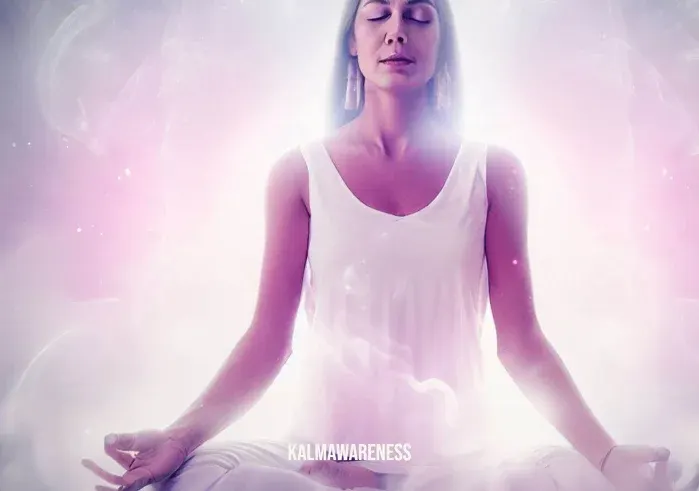The Power of Guided Meditation for Deep Sleep and Relaxation
Why Guided Meditation for Deep Sleep and Relaxation?
A night of deep, restful sleep is a luxury many of us yearn for. But, have you ever tried guided meditation for deep sleep and relaxation? This scientifically proven practice may well be your ticket to peaceful nights and refreshed mornings. Let’s delve into why it’s beneficial and how it’s done.
If you’re wondering, “why is it so hard to meditate?”, know that guided meditation simplifies the process. Instead of wrestling with your thoughts, guided meditation allows you to focus on the narrator’s soothing voice, leading you towards serenity.
The Benefits of Guided Meditation for Deep Sleep
Sleep disturbances are more than mere annoyances. They can significantly impact your quality of life. Embracing guided meditation can counteract these effects, leading to rejuvenating sleep and ultimately, better health. Let’s explore these benefits:
- Reduces Stress: If the strains of daily life are causing your sleep to suffer, guided meditation can be an effective remedy. It encourages relaxation by redirecting focus away from your stressors.
- Helps You Fall Asleep Faster: If you’re one of those people who toss and turn before finally succumbing to sleep, guided meditation for sleep can be a game-changer. It’s all about training your mind to shift from the frenzied rhythm of the day to a peaceful state conducive to sleep.
- Improves Sleep Quality: Good sleep isn’t just about quantity—it’s about quality, too. Guided meditation can help you reach the deeper stages of sleep where your body rejuvenates itself.
- Boosts Mental Health: The practice of guided meditation isn’t merely a sleep aid. It’s a powerful tool in promoting overall mental wellness, providing a sense of peace and tranquility that permeates your entire day.
Guided meditation isn’t a quick fix, though. It’s a practice that requires time and consistency. You may ask, “Why does my head hurt when I meditate?” But with practice, you’ll soon realize it’s your mind’s way of adjusting to a new rhythm of peace and relaxation.
How Guided Meditation for Sleep Works
Now that you understand the benefits let’s move on to how this form of meditation works. If you’re a beginner, guided meditation is a great place to start. It requires little effort from your end—only your full attention and an open mind.
You simply tune into a meditation sleep story or a guided meditation audio. These narrations are designed to draw you into a deeply relaxed state, priming your mind and body for sleep.
As you listen, visualize the story or the instructions being narrated. This concentration helps to shut out the noise of the outside world and the chatter within your mind, guiding you gently into sleep.
Along the way, you may also explore the fascinating world of brain waves for anxiety, another approach that can help reduce nighttime stress and promote deeper sleep.
Conclusion
Guided meditation for deep sleep and relaxation is a journey—a journey into the deeper realms of consciousness where rest and rejuvenation reign. It’s a journey worth undertaking if you wish to experience the true essence of restful sleep.
Take a moment to reflect on the benefits and the workings of guided meditation for sleep that we’ve covered in this section. But our journey into the realms of peaceful sleep doesn’t end here.
Please join us in the next part of the article where we’ll delve deeper into the practicalities of guided meditation for sleep. We’ll explore different methods, helpful tips, and answer common queries about guided meditation for sleep. Let’s continue our journey towards restful nights and refreshing mornings.

Exploring Different Methods of Guided Meditation for Deep Sleep
While the concept of guided meditation for sleep remains the same, there are various methods one can use to achieve deep sleep and relaxation. Let’s take a look at these different methods and understand how each one can help us attain a state of tranquility before sleep.
1. Body Scan Meditation
This is a type of mind-ease practice that involves focusing your attention on different parts of your body. Starting from the toes and moving upwards, this technique helps you connect with your body and relaxes you in the process.
2. Breathing Techniques
Another popular method is using different breathing techniques for relaxation. For example, practicing a breath wave or left nostril breathing before sleep can significantly calm your mind and prepare it for deep sleep.
3. Visualization
In this method, you are guided to visualize peaceful and calming scenarios. It could be a beautiful forest, a quiet beach, or anything that brings you peace. This method is effective in calming your mind and preparing it for sleep.
4. Progressive Muscle Relaxation
This technique involves tensing and then relaxing different muscle groups in your body. It can be combined with a jaw relaxation meditation for a full-body relaxation effect.
5. Mantra Meditation
This method involves silently repeating a calming phrase or a mantra to help you relax. The mantra can be anything from ‘I am calm and relaxed’ to ‘peace flows through me.’ This method is particularly useful for those who struggle with intrusive thoughts at bedtime.
Let’s take a look at a comparison of these techniques in the table below.
| Method | Effect | Perfect for |
|---|---|---|
| Body Scan Meditation | Promotes awareness and relaxation | Those who enjoy mindfulness |
| Breathing Techniques | Calms the nervous system | Those who struggle with anxiety |
| Visualization | Provides mental escape and relaxation | Those with active imaginations |
| Progressive Muscle Relaxation | Helps in physical relaxation | Those with physical tension |
| Mantra Meditation | Helps in mental relaxation | Those who struggle with bedtime thoughts |
Creating Your Guided Meditation Routine
Now that you know the different methods, the next step is to establish your guided meditation for deep sleep and relaxation routine. Here are some steps you can follow:
- Choose Your Method: Refer back to the methods mentioned above, and choose one that you feel most drawn to. Remember, the right method is the one that resonates with you the most.
- Create a Calm Environment: To make your meditation effective, it’s essential to create a calm and peaceful environment. This could involve dimming the lights, using calming rain sounds or even investing in relaxation bed accessories to make your sleep space comfortable and conducive to relaxation.
- Follow the Instructions: Whether you’re listening to a guided meditation audio or reading from a script, be sure to follow the instructions. Each instruction is designed to guide you deeper into relaxation and closer to sleep.
- Practice Regularly: Like any other skill, the more you practice guided meditation, the better you’ll get at it. Establishing a regular routine will make it easier for your mind and body to enter a state of deep relaxation, paving the way for restful sleep.
As we delve further into this topic, you may ask, “Can I meditate after eating?” and the answer is yes, but it’s best to give your body some time to digest the food before you start meditating.
Conclusion
Guided meditation for deep sleep and relaxation can work wonders for your sleep health and overall wellbeing. It’s all about finding the right method that works for you and integrating it into your nightly routine.
We have discussed various methods and steps to create a guided meditation routine in this chapter. In the next part of the article, we’ll be looking at some of the common challenges people face when starting with guided meditation for sleep and how to overcome them. We’ll also provide some tips to enhance your guided meditation experience. Let’s continue our journey towards achieving serene nights and energetic days!

Overcoming Challenges and Enhancing the Guided Meditation Experience
Adapting to guided meditation for deep sleep and relaxation can be a challenging endeavor. This part of the article will address some common obstacles faced by beginners and provide practical solutions. Also, we’ll touch upon how to improve the overall meditation experience.
Addressing Common Challenges in Guided Meditation
1. Distraction
As the old Buddhist saying goes, “Your worst enemy cannot harm you as much as your own unguarded thoughts.” Distraction is a common hurdle faced by many, especially beginners. Whether it’s the stress of the day or the ticking of a clock, many struggle with keeping their focus during guided meditation.
To overcome this, try to create an environment free of interruptions. Turn off your devices, choose a quiet place, and use soothing alarm sounds to wake up instead of abrupt alarms that can disrupt your sleep rhythm.
2. Physical Discomfort
As Gautama Buddha once shared, “To keep the body in good health is a duty, otherwise we shall not be able to keep our mind strong and clear.” For meditation, your body needs to be comfortable. Discomfort during meditation can be due to unsuitable sitting or lying positions, or due to undiagnosed health issues like why your head hurts when you meditate. In such cases, it’s best to consult a doctor or a meditation expert.
3. Difficulty in Following the Meditation Script or Audio
In the words of Jon Kabat-Zinn, “Meditation is the only intentional, systematic human activity which at bottom is about not trying to improve yourself or get anywhere else, but simply to realize where you already are.” If you are struggling to follow a particular script or audio, remember that it’s okay. Meditation isn’t a competition. Try different scripts or audios until you find one that works for you. You might want to explore paradoxical relaxation audio or meditation sleep stories to find what suits you best.
Enhancing the Guided Meditation Experience
1. Consistency is Key
The Latin phrase “Repetitio est mater studiorum” (Repetition is the mother of learning) applies here as well. Practice consistently. Make your guided meditation for deep sleep and relaxation a daily ritual. Over time, you will notice an improvement in your sleep quality and overall well-being.
2. Use of Aromatherapy
Incorporating aromatherapy into your meditation routine can enhance the experience. Use calming scents like lavender and chamomile to create a relaxing environment. You could use essential oils or aromatic candles, whatever you prefer.
3. Dietary Considerations
Did you know that what you eat can also impact your meditation experience? Eating a light and healthy meal before meditation can make a significant difference. Heavy meals can make you feel lethargic and hinder your focus. Understand why it’s not recommended to meditate at night after eating for more insight.
4. Incorporating Yoga
Incorporating yoga for night before your meditation routine can enhance the relaxation experience. Yoga helps in calming the body and mind, preparing you for a deeper meditation experience.
In conclusion, overcoming challenges in guided meditation and enhancing the experience is a journey in itself. As with any journey, there will be bumps along the way, but with patience and persistence, the path to achieving deep sleep and relaxation through guided meditation becomes smoother.
In the next chapter of the article, we will delve into the science behind why guided meditation works for deep sleep and relaxation, and we’ll also take a look at some empirical evidence supporting the effectiveness of meditation for sleep. We invite you to continue exploring the fascinating world of guided meditation with us!

Understanding the Science Behind Guided Meditation for Deep Sleep and Relaxation
As we continue our exploration of guided meditation for deep sleep and relaxation, let’s delve into the science behind its effectiveness. We’ll also look at the hope and confidence that meditation can instill within us. This deeper understanding will demystify guided meditation and reinforce its efficacy.
How Does Guided Meditation Work for Sleep and Relaxation?
Scientific studies have established a connection between guided meditation and improved sleep quality. The process primarily involves the interplay between the brain, nervous system, and the body’s relaxation response. Let’s examine this:
1. Activation of the Parasympathetic Nervous System
During guided meditation, the body’s parasympathetic nervous system — responsible for promoting relaxation and rejuvenation — is activated. This counteracts the effects of the sympathetic nervous system, which is often over-stimulated due to stress and anxiety. If you are interested to learn more about how brain waves affect our emotions, you can visit brain waves for anxiety.
2. Lowering Cortisol Levels
Guided meditation helps reduce the levels of cortisol, the body’s primary stress hormone. High levels of cortisol can lead to sleep disturbances. By lowering cortisol levels, guided meditation promotes a peaceful and more restful sleep.
3. Enhancing Melatonin Production
Melatonin is a hormone that regulates sleep-wake cycles. Guided meditation can stimulate the pineal gland to produce more melatonin, helping you achieve a deeper and more restful sleep. Understand more about how the human body reacts to sound and meditation by exploring body sounds list.
As Mahatma Gandhi once said, “Each night, when I go to sleep, I die. And the next morning, when I wake up, I am reborn.” With consistent practice, guided meditation can indeed lead to rebirth each morning — waking up rejuvenated after a deep and relaxing sleep.
Research Supporting Guided Meditation for Deep Sleep
Several studies have shown that guided meditation has a positive impact on sleep quality. Here’s a snapshot of the evidence supporting guided meditation for sleep:
| Study | Findings | More Information |
|---|---|---|
| Journal of the American Medical Association (JAMA) Internal Medicine, 2015 | Mindfulness meditation improves sleep quality in older adults suffering from sleep disturbances | Meditation Sleep Stories |
| Sleep Journal, 2019 | Guided meditation is associated with better sleep quality among employees exposed to work stress | Calm Heart Meditation |
| Sleep Science and Practice, 2020 | Mindfulness meditation reduces insomnia symptoms in cancer survivors | A State of Calm |
| International Journal of Nursing Studies, 2018 | Mindfulness-based stress reduction (MBSR) significantly improved sleep quality in nurses | Mind Ease |
| British Journal of Health Psychology, 2019 | Mindfulness meditation reduces sleep-interfering cognitive processes in individuals with insomnia | Breathe it in |
While guided meditation can undoubtedly help achieve deep sleep and relaxation, it is essential to remember that it is a journey rather than a destination. The popular saying by Lao Tzu “A journey of a thousand miles begins with a single step” can be aptly applied here. The first step is to start practicing meditation regularly.
In the next chapter, we will look at some practical guided meditation exercises that you can try for deep sleep and relaxation. We also look at how to prepare the perfect environment for your meditation. Continue reading for more insightful and practical tips to enhance your guided meditation journey.

Guided Meditation Techniques for Deep Sleep and Relaxation
After understanding the science and benefits behind guided meditation for deep sleep and relaxation, we now dive into the practical aspects. Here, we will explore various techniques that you can incorporate into your daily routine. These techniques range from different breathing exercises to using soothing sounds and setting up the perfect environment for your practice.
1. Breathing Exercises for Deep Sleep and Relaxation
Breathing exercises are fundamental to meditation. They help slow your heart rate and calm your mind, preparing you for a deep and restful sleep.
- Deep Breathing: Deep breathing or diaphragmatic breathing involves inhaling deeply through your nose, filling your lungs with air, and exhaling slowly through your mouth. You can follow along with this Breath Wave guide.
- 4-7-8 Breathing: This technique involves inhaling for a count of four, holding the breath for a count of seven, and exhaling for a count of eight. For a variation of this exercise, you can try the Left Nostril Breathing Before Sleep.
2. Visualizations and Affirmations
Visualization and affirmation exercises can enhance the effectiveness of your guided meditation. These techniques aim to replace negative thoughts with positive ones, helping to reduce anxiety and promote a peaceful sleep.
- Positive Affirmations: Repeat positive statements either out loud or in your mind before you sleep. This can help shift your mindset and alleviate stress. Check out these Breathing Affirmations for a start.
- Visualization: Imagine a peaceful and tranquil place, like a serene beach or a quiet forest. This can help your mind focus and reduce racing thoughts. Try to incorporate as many senses as possible, imagining the sounds, smells, and sensations of your peaceful place.
3. Setting Up Your Meditation Environment
Your meditation environment can significantly impact the effectiveness of your practice. A calm and serene atmosphere can promote relaxation and help you fall asleep faster.
- Choose a Comfortable Spot: Select a quiet and comfortable spot in your house where you will not be disturbed. This might be your bedroom, a dedicated meditation space, or even your backyard.
- Use Soothing Sounds: Sounds can play a crucial role in promoting relaxation and deep sleep. You can use sounds like calming rain, white noise, or 528 Hz Frequency Benefits Sleep for a more effective meditation.
- Comfortable Bedding: Ensure that your bedding is comfortable. The right mattress and pillows can significantly improve your sleep quality. You can learn more at Relaxation Bed.
By incorporating these guided meditation techniques for deep sleep and relaxation, you are bound to see a significant improvement in your sleep quality and overall well-being.
In the concluding chapter, we’ll provide a step-by-step guide for an effective guided meditation session before sleep. Additionally, we will address some common concerns related to guided meditation. So stay tuned for a comprehensive guide that will transform your bedtime routine and your life! As Buddha once said, “Each morning we are born again. What we do today matters most.” Let’s make our sleep matter the most.

Setting Sail Towards Restful Nights – Your Guided Meditation Journey
Congratulations! You’ve reached the last leg of our journey exploring guided meditation for deep sleep and relaxation. You’ve gained a wealth of knowledge about the science behind sleep, the benefits of guided meditation, various techniques, and how to implement them. Now, it’s time to set sail towards restful, rejuvenating nights of sleep.
Preparing for your Guided Meditation Journey
Before we begin, let’s ensure we are well-prepared. Make sure you have a quiet and comfortable space ready for your meditation. You might want to dim the lights and set up some soothing sounds from the Calming Rain collection. Remember, the goal here is to create a serene and relaxing environment.
You might also want to incorporate a pre-sleep routine. For instance, sipping on a calming herbal tea from the Tea for Meditation collection could enhance the experience.
Step-by-Step Guided Meditation for Deep Sleep and Relaxation
Let’s go through a simple step-by-step process of a guided meditation session. You can either follow this process by yourself or use a guided meditation audio. Here’s an example of a Paradoxical Relaxation Audio that you could use.
- Position Yourself Comfortably: Sit or lie down in a position that feels comfortable. Ensure that you can stay in this position without feeling any discomfort.
- Close Your Eyes and Breathe: Close your eyes and take slow, deep breaths. Feel your chest rise and fall as you breathe in and breathe out.
- Relax Your Body: Starting from your toes, visualize each part of your body relaxing as you breathe out. Gradually work your way up, ending at your head. The Jaw Relaxation Meditation could help with this.
- Visualize a Peaceful Place: Imagine yourself in a peaceful place. It could be a beach, a forest, or even a place from your memories.
- Continue Breathing and Relaxing: Continue taking slow, deep breaths as you bask in the tranquility of your peaceful place. If your mind wanders, gently bring it back to your breathing and your peaceful place.
- Slowly Return to Reality: When you’re ready, slowly bring your awareness back to reality. Wiggle your fingers and toes, and when you’re ready, slowly open your eyes.
That’s it! You’ve completed your first session of guided meditation for deep sleep and relaxation. Remember, consistency is key. The more you practice, the better your sleep will get.
And with that, our journey comes to a close. Guided meditation is a wonderful tool, but it’s just one piece of the puzzle. Explore more of KalmAwareness’s resources for a holistic approach to better sleep and relaxation. From exploring Why it’s so hard to meditate to understanding Why does my head hurt when I meditate, there’s a wealth of knowledge waiting for you.
As the Dalai Lama wisely said, “Sleep is the best meditation.” So here’s to many nights of restful sleep and serene meditation. After all, each restful night is the start of a productive and joyful day. Sweet dreams and happy meditating!





